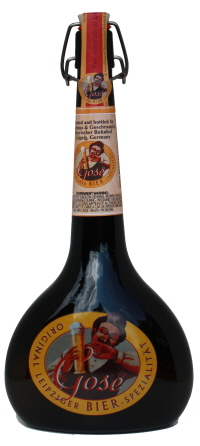Top Tastings 2011
ABV: 4.6%
Origin: Leipzig, Sachsen, Germany
Website: www.gose.de
Gose remains one of the world’s most neglected historic beer styles, perhaps because the handful of breweries producing it remain small craft affairs and until recently it’s rarely been available outside its Saxon heartland. Michael Jackson was writing about it in the various editions of his Pocket Beer Book in the 1990s but it’s not covered by beer competition style guidelines like those issued by the BJCP and has been missed entirely from recent voluminous reference tome The Oxford Companion to Beer. I’ve not yet had the opportunity to track it down at source and had never seen it for sale in the UK or in other parts of Germany, so broke my usual rule of buying exclusively domestic beers while travelling when I spotted bottles from the oldest established Gose revivalist on sale at City Beer Store in San Francisco.
Gose is a wheat beer, but not of the Bavarian variety most familiar in Germany. Instead it’s one of the family of traditional, cloudy and often sour and/or spiced wheat beers once brewed across an arc of Europe that included southern England and the Low Countries as well as northern Germany. Like Belgian witbier, it’s flavoured with coriander, but also has added salt – a practice that would have been frowned upon in Bavaria, where the Reinheitsgebot outlawed the use of flavourings other than hops. It’s naturally conditioned, and was traditionally matured in distinctive bottles with long, narrow necks that weren’t stoppered, but sealed by rising yeast.
Its close relatives include Berliner Weisse and lambics – like the latter it was once spontaneously fermented, although the similarity between the name of the style and the Dutch term ‘geuze’ is likely coincidental. In fact Gose gets its name from Goslar, the city in Lower Saxony where it was first brewed in the early 18th century. But it achieved ascendancy in the great and historic Saxon city of Leipzig, where it became known as the local style, with its own local breweries, some of them set up by relocated Goslarers.
In the first half of the 20th century, Gose went into decline, not helped by the brewers’ practice of deliberately limited supply, and production ceased during World War II. It was revived in 1949 by a private brewer, Friedrich Wurzler, at a scale so small the brewery slipped under the nationalisation radar following the founding of the Deutsche Demokratische Republik (DDR, the Stalinist state otherwise known as East Germany) the same year. When Wurzler’s successor died in 1966, Gose became an extinct style, curiously at about the same time when the related style of Brabant witbier was being resurrected from extinction by Pierre Celis in Hoegaarden.
Gose’s own resucitation happened in 1986, three years before the fall of the Berlin Wall, when Lothar Goldhahn refurbished a historic Leipziger pub, the Ohne Bedenken (‘Without consideration’), and determined to revive the tradition of serving the beer. Initially his revived Gose, its recipe developed with the help of a former Wurzler employee and older drinkers with good memories, was contract brewed at the Schultheiss brewery in East Berlin. After reunification, Goldhahn had his own brewery for a while, then contracted to the Andreas Schneider brewery in Weissenburg, Bavaria (no relation to the more famous Schneider Weissbier brewery in Kelheim), who were clearly prepared to be flexible about the Reinheitsgebot.
In 1999, Andreas Schneider bought its own brewpub in Leipzig, in Germany’s oldest surviving railway station, the Bayerischer Bahnhof (‘Bavarian Station’, currently closed to trains due to construction of a new tunnel but due to reopen this year). The brewery here now supplies Ohne Bedenken and is the source of the bottles that have found their way onto the export market, in packaging that includes modern versions of the traditional bottles, although conventionally sealed with a flip-top stopper. A handful of other German breweries have also picked up on the style, including one in Goslar, and the ever innovative US craft brewing sector has experimented with its own versions.
My sample of the Bayerischer Bahnhof version, in a standard US 12oz (355ml) bottle rather than a fancy custom one, poured a cloudy dirty yellow with a thick white head. A gritty aroma was lightly tinged with coriander, heralding a delicate, creamy cereal palate with tangy citrus and only very lightly sour notes kicking in. Spices lurked in the background and a slight orange flavour developed, but though salt was evident, I’ve had beers without added salt that tasted saltier. More cereal lingered in a lightly fruity and pleasantly spicy finish, rounding off a tasty, well balanced, subtle, rounded and refreshing beer that rewarded my lengthy wait to taste it.
I admit I’ve shamelessly cribbed much of the historical background from the reliably authoritative Ron Pattinson, who provides further detail at www.europeanbeerguide.net/leippubs.htm.






Think you were telling me about this one at the Guild dinner. Sounds very interesting indeed, although I have absolutely no ideas how “long, narrow necks that weren’t stoppered, but sealed by rising yeast” is possible!
BeerBirraBier.
Cheers Mark. There’s more of an explanation in Ron’s piece. I believe the long neck encouraged a depth of yeast barm, like on the top of a traditional open fermentation vessel, which dried and stuck as fermentation subsided, but I don’t imagine the beer was intended to keep for very long.
I think it’s a lovely beer, spent an afternoon there with brewmaster Mattiaus late 2010 — I loved what I felt was a tanginess on the palate and a body from the salt, tried another breweries Gose at a Gose tavern, that was far saltier and I made the mistake of drinking kummel with it…